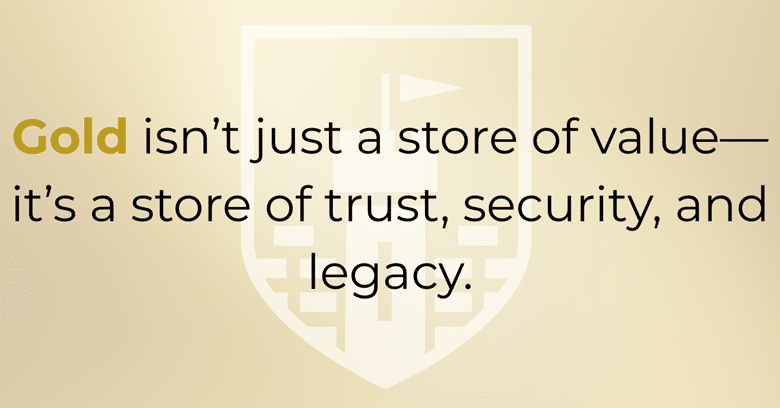True wealth isn’t just numbers on a balance sheet—it’s the gift that protects, generation after generation. Across centuries and continents, gold has quietly served as the cornerstone of enduring family fortunes. It’s not chosen for flash, but for permanence.
In today’s complex financial world, high-net-worth families face a persistent challenge: How do you preserve wealth across generations—through inflation, policy shifts, and market volatility?
The answer—at least in part—is timeless: physical gold.
Gold Has Outlasted Empires, Currencies, and Crashes
Some assets are seasonal. Gold is perennial.
When the U.S. abandoned the gold standard in 1971, an ounce of gold was worth about $35. As of April 12, 2025, that same ounce is now worth $3,254.50. That reflects a compound annual growth rate (CAGR) of approximately 8.3% over 54 years—delivering not just appreciation, but a steady preservation of real purchasing power across generations.
While fiat currencies have steadily declined—eroded by inflation, debt, and political decisions—gold has held its ground. An ounce of gold still buys roughly the same amount of essential goods it did a century ago. That’s not coincidence. That’s resilience.
Gold doesn’t just keep up—it holds its own against inflation and policy missteps alike.
Families That Understand Wealth Build with Gold
The most enduring family fortunes have always included gold—not as speculation, but as insurance. From the Rothschilds to today’s central banks and leading family offices, physical gold remains a foundational asset.
Why? Because gold is:
- Tangible – You can hold it. You can store it. It’s not dependent on anyone else’s promise to pay.
- Durable – Gold doesn’t rust, spoil, or degrade over time.
- Borderless – Gold is recognized as valuable in every country, regardless of regime or currency.
The legendary financier J.P. Morgan, testifying before Congress in 1912, put it plainly:
“Money is gold, and nothing else.” — J.P. Morgan, Pujo Committee Hearings, Dec 18, 1912
More than a century later, his words still resonate. When trust in institutions falters, gold remains a store of value that needs no explanation—and no counterparties.

Gold is a store of value and a whole lot more.
Gold Is No One’s Liability
Gold is one of the few assets in the world with no counterparty risk. Stocks rely on earnings. Bonds rely on repayment. Real estate relies on tenants. But gold? Gold simply is—an elemental reserve that requires no yield, no promise, no counterparty.
When families own physical gold outright—especially when held in a secure, third-party vault with clear title—they eliminate exposure to banking failures, political decisions, or broken promises.
In uncertain times, that peace of mind is priceless.
A Legacy Asset That’s Easy to Pass On
Gold simplifies the complexities of estate planning. It requires no management, can be titled into trusts or estate structures, and is easy to divide among heirs. When properly held, it is free from entanglements with financial institutions—making it ideal for streamlined intergenerational transfer.
Some families go further by placing gold into Clear Title Accounts, which provide professional custody, independent audits, and seamless transfer between generations. Others use Capital Accounts to unlock liquidity without ever needing to sell—borrowing against their gold while preserving the asset for future heirs.
Gold doesn’t just preserve wealth. It preserves options.
Gold Performs When Other Assets Don’t
While equities can offer growth, they also bring volatility. In moments of crisis, gold often shines brightest:
- During the 2000–2002 tech crash, gold rose over 16% while the S&P 500 dropped 45%.
- During the 2008 financial crisis, gold gained over 25% in just 16 months.
- In the COVID market panic, gold surged 30% from early 2020 to mid-2021.
And today? Gold has reached a new all-time high of $3,254.50 per ounce, driven by:
- Soaring central bank demand (over 1,000 tonnes purchased in 2023)
- Rising global debt levels and persistent inflation
- Increasing demand for non-dollar reserves among nations like China and India
Geopolitical instability and a growing loss of trust in fiat systems
These aren’t temporary trends. They are long-term signals. For families safeguarding long-term capital, this performance isn’t just impressive—it’s strategic.
Gold as an Intergenerational Pillar
Modern wealth planning isn’t just about asset growth—it’s about asset endurance. It’s not how fast your portfolio grows—it’s how long your wealth lasts.
Families that think in decades—not quarters—are increasingly revisiting this age-old asset for three key reasons:
- Continuity – Gold preserves purchasing power and transcends market noise.
- Clarity – Gold is simple to own, simple to value, and simple to pass on.
- Control – Gold held with proper legal title and custody offers direct ownership, privacy, and liquidity.
In this way, gold becomes more than a hedge. It becomes a pillar of the family strategy.
Inheritance Is More Than Money
When you pass on gold, you pass more than money. You pass on a mindset—a commitment to stewardship, stability, and independence.
In a world where so many assets depend on someone else’s promise, gold stands alone as an unshakable reserve of value. It’s not just a commodity. It’s a legacy.
Take the Next Step in Securing Your Wealth
If you’re building or stewarding multigenerational wealth, there’s no better time to explore how physical gold can strengthen your family’s plan. Structured properly, it can provide not just safety—but certainty.
This article is for informational purposes only and does not constitute financial, legal, or investment advice. Past performance of gold or other assets is not indicative of future results. Investment decisions should be made based on your own objectives, financial situation, and needs. Please consult with a qualified financial advisor before making any investment decisions.





